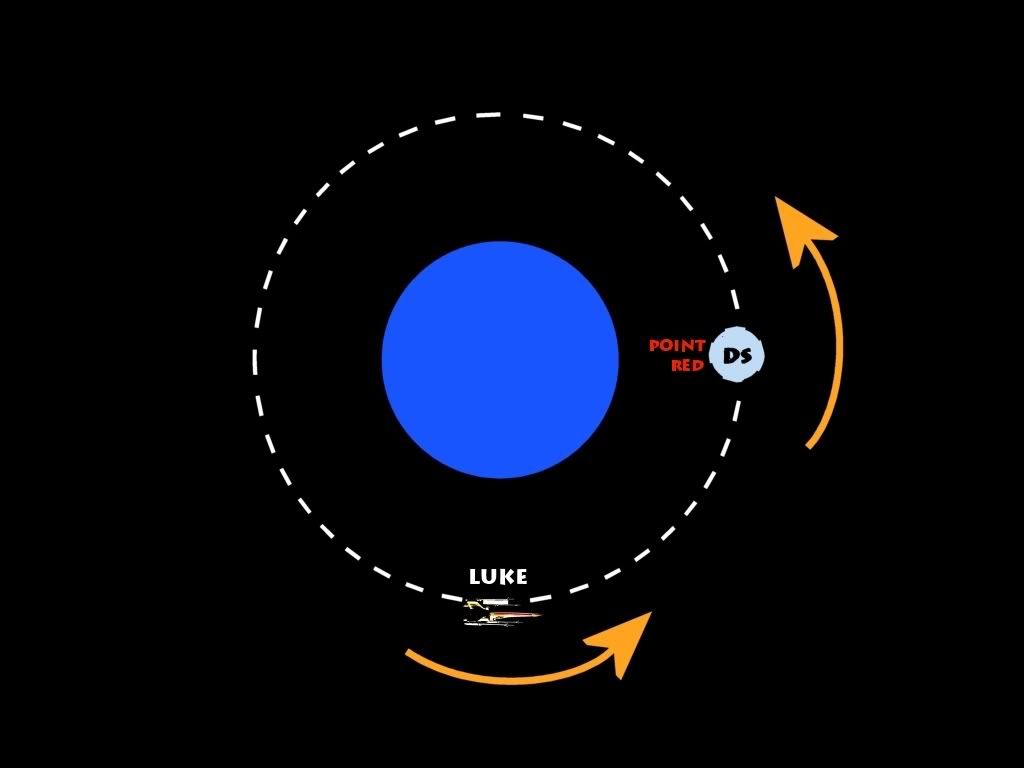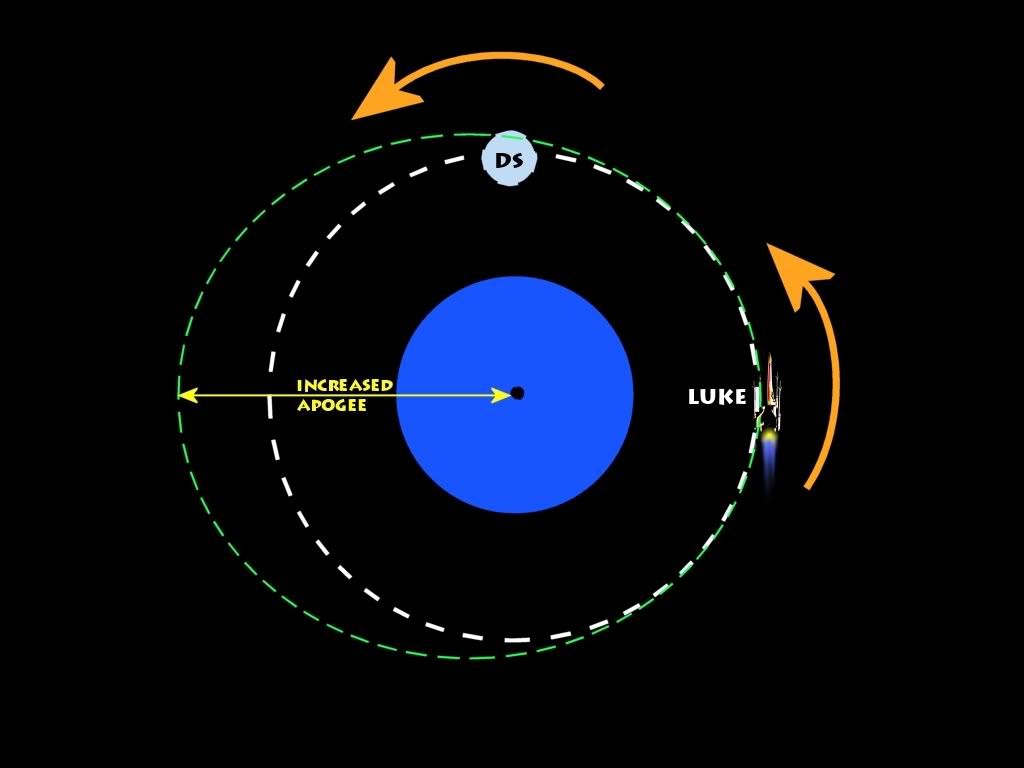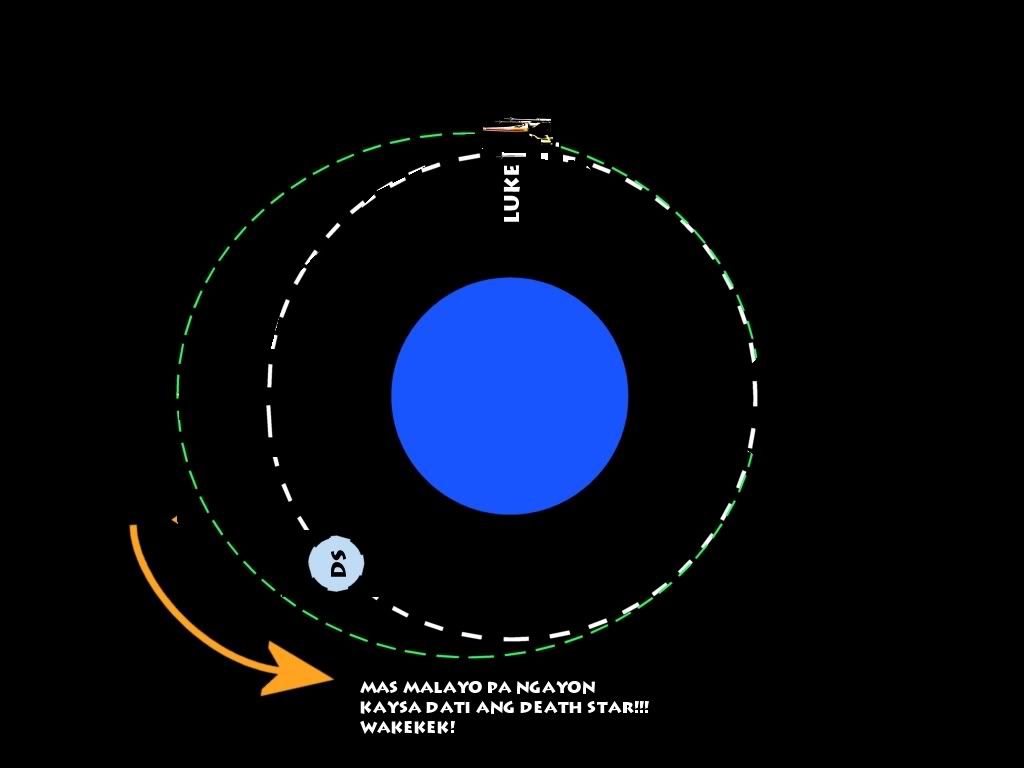Ok, time sa....this is a repost I did from another forum I participated in a few years back, but it essentially explains the whole thing, but please substitute the space shuttle with an X-wing fighter, and substitute the ISS with "Death Star" okay?
So here goes...
Imagine Luke Skywalker, in his X-Wing, orbiting some earth-like planet. His throttle is set to ZERO, and he is freefalling around the planet, like how satellites, the space shuttle, and the ISS do in our own low earth orbit. About the same altitude, also orbiting this planet, but several hundred miles away, is the Death Star...
Now, Luke wants to pee very badly (bladder is full), and the nearest comfort room is aboard the Death Star. So Luke says "Aha! Since my X-wing and the Death Star are on the same altitude/orbit, all I have to do is engage my thrusters to full, and I'll coast gently until I reach the Death Star!...piece of cake hehehe!" So Luke when Luke reaches Point Red, he engages the X-wing's throttle to MAX...
But, since our dear Luke is trained in STAR WARS PHYSICS and not REAL WORLD NEWTONIAN AND KEPLERIAN PHYSICS, he mistakenly assumes that the increase in throttle would result in an increase in VELOCITY, which is true if he was flying an AIRPLANE in earth's ATMOSPHERE...but hey Luke, this ain't the skies of Kansas or Tatooine anymore boy--this is SPACE...
What happens is, when he pushes throttle to MAX, he increases his orbit's APOGEE or highest point, because according to Kepler, speed is fastest in the lowest point of orbit around a gravitating body. Thus, the increase is velocity actually becomes translated to an increase in apogee DIRECTLY opposite the side of the planet where the X-wing is on! The green dashed line is actually the new orbit of the X-wing, but our poor Luke doesn't know this...
Now Luke gleefully waits until he reaches the Death Star...but as time passes by he notices something very strange...the Death Star seems to drift FARTHER and FARTHER..why or why is this so? It's because now, Luke is riding the green orbit with the higher apogee...
...a higher orbit means less energy (slower), and thus, counterintuitively, Luke realizes that his increase in THRUST TOWARDS the direction of the DEATH STAR meant that he will DRIFT FARTHER AWAY FROM IT...
...and that my friends, is the consquence of NOT knowing certain fundamental laws of Orbital Mechanics...
...you will pee in your pants! Hihihihihi
If you don't believe me, then read this...
Fresh Brainz: Counterintuitive Science: Orbital Mechanics
...good thing McDivitt and White didn't have to go to the bathroom eh
Now when I made this explanation, I didn't make diagrams on what Luke MUST do to reach the Death Star...and that, I will post in a while kay busy pa ko ron hehehe. Or wait...maybe someone else here knows what Luke MUST DO to reach the Death Star? That could be our NEXT CHALLENGE...hehehe...sige daw be.
-RODION
Results 41 to 50 of 140
-
06-03-2009, 04:56 PM #41
Last edited by rodsky; 06-03-2009 at 05:02 PM.
-
06-03-2009, 05:03 PM #42
-
06-03-2009, 05:14 PM #43
@rodsky
you said gravity has nothing to do with the manuever, pero ngano mn if ang object if positioned on lower orbit or nearest sa planet has higher rotational speed than the shuttle in higher orbit..i think ang gravity has the big role ani..hehe
-
06-03-2009, 05:17 PM #44
Gravity is all-encompassing and of course it has a big role in the setup, but that's not the point of the argument. GIVEN na man na, that gravity influences both the shuttle and the ISS, but it has NOTHING TO DO with the question of HOW the shuttle (or the X-Wing in my explanation above) can reach the ISS.
-RODION
-
06-03-2009, 05:18 PM #45
-
06-03-2009, 05:28 PM #46
@rodsky
you also did not mention the default location sa shuttle if its in the left or right side sa ISS...
where in imng diagram is opposite from your first illustration...
-
06-03-2009, 05:49 PM #47
I don't understand what you mean. Klaro kaayo from the diagram that the shuttle is on the left side of the screen, and the ISS on the right side. Allow me to repost it:

Based from the F-16 diagrams, it's logical to infer that the shuttle and the ISS are moving "left to right" or in this case, orbiting the earth in a clockwise direction.
-RODION
-
06-03-2009, 05:58 PM #48
Ok, let's answer the question...how then, can Luke Skywalker reach the Death Star, or what is the shuttle supposed to do, to reach the ISS? Hopefully, the following diagrams will illustrate the solution:
Here, the shuttle and the ISS are on the same orbit (same altitude, thus same radius from the center of the earth). In this state, they will both revolve around the earth, and there will be NO CHANCE for the shuttle to reach the ISS if it doesn't do anything. So how can it reach the ISS?

First, the shuttle needs to turn around 180 degrees, pointing it's nose AWAY from the direction of travel, or away from the ISS. This is the counterintuitive part--to get to where you are going, you have to point towards the opposite direction!
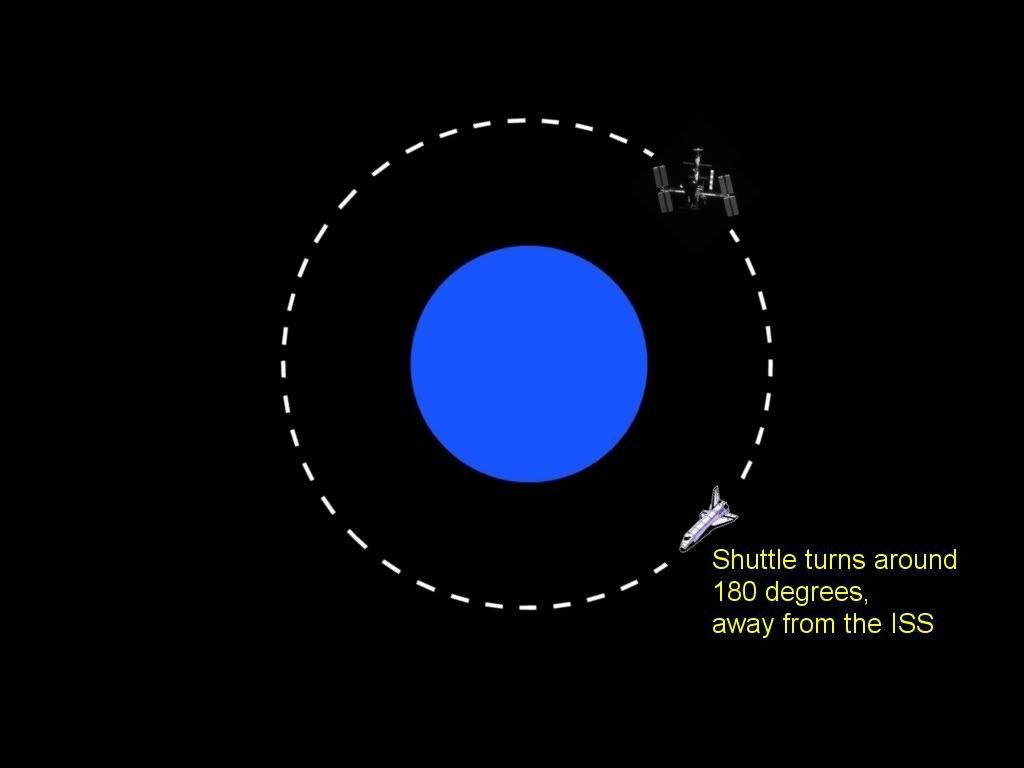
Shuttle then fires its main engines, called the OMS engines, to change the shape of its orbit to an ellipse with a smaller radius than the ISS' orbit.

The shuttle is now coasting along its new, green orbit line...it's much faster than the ISS now, so it can overtake it soon.

Fast forward...Let's assume that both the ISS and the shuttle have orbited the earth about 30 times...because it takes a long time for the shuttle to catch up to the ISS...
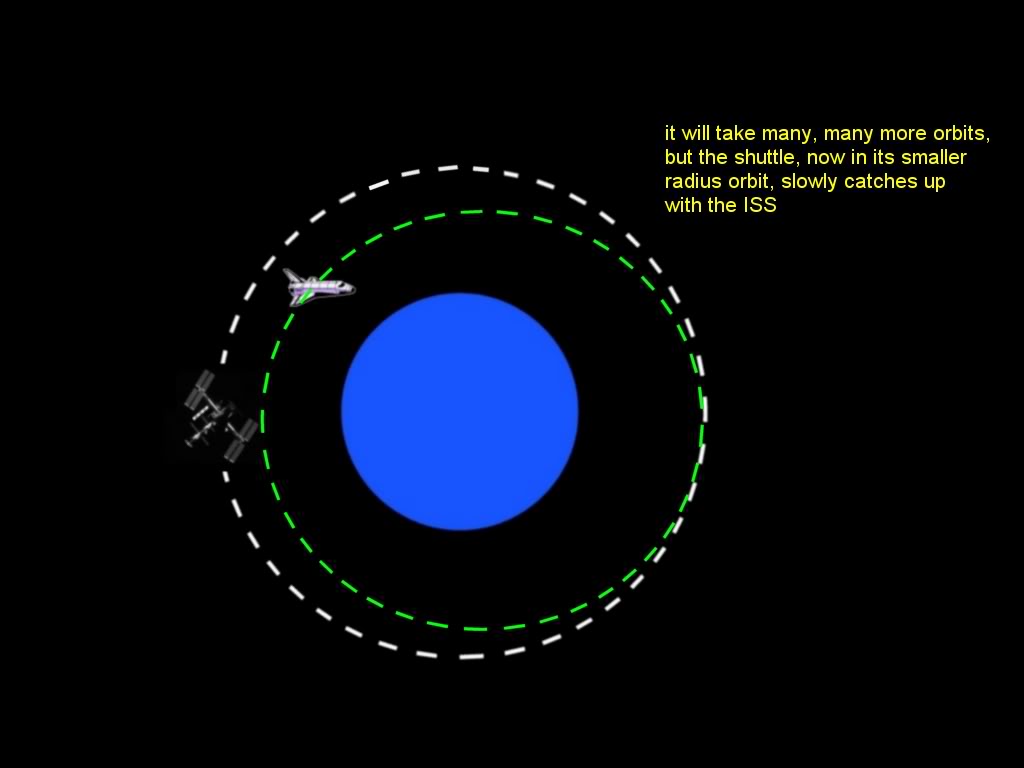
Once the ISS nears...the shuttle has to turn around 180 degrees again, and POINT TO THE ISS...and then do another burn...this time it's the PROGRADE burn, so that its orbit ellipse will become bigger again...and thus slowing it down, allowing it to approach the ISS carefully.
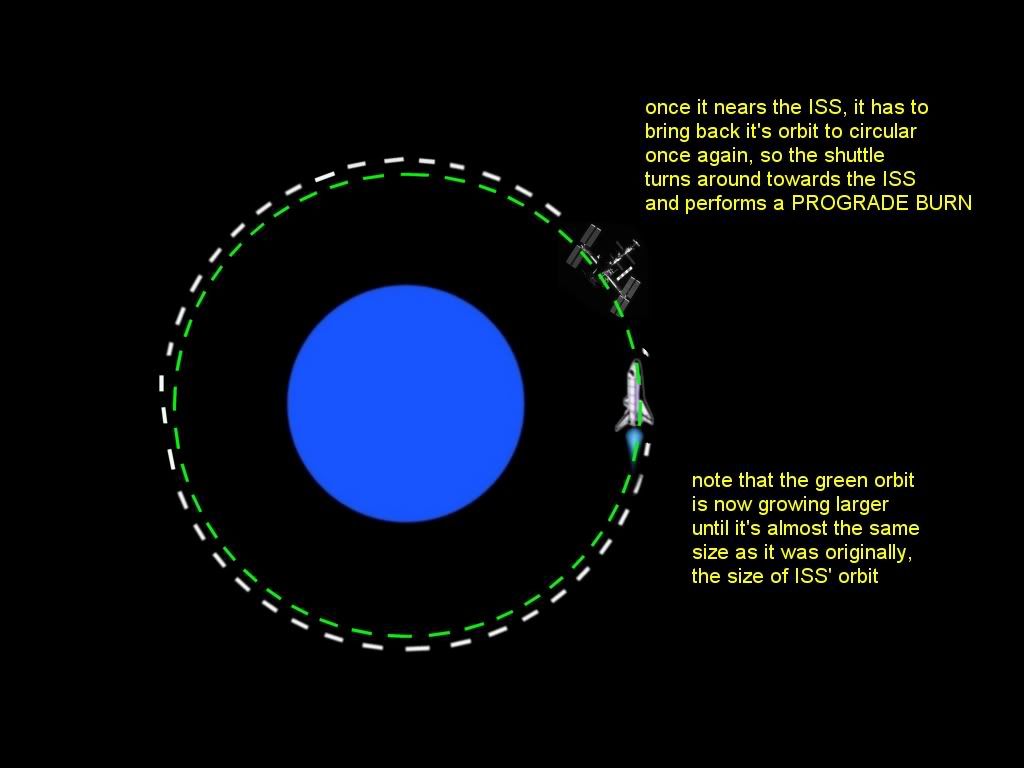
It will then try to match orbits with the ISS, by continuously increasing apogee in little bits (via small prograde burns) until they're only a few hundred meters from each other, and by then, the shuttle can then slowly "drift" towards the shuttle using not its OMS engines, but the RCS thrusters.
And that, is how you get the shuttle to reach the ISS
-RODIONLast edited by rodsky; 06-03-2009 at 06:04 PM.
-
06-03-2009, 06:04 PM #49
here's more trivia for space shuttles and their operations.. in layman's terms..

How is the space shuttle configured and operated?
The space shuttle system consists of a main liquid fuel tank, two solid rocket boosters (SRBs), and the shuttle orbiter. When the shuttle is launched, the orbiter and SRBs are attached to the main fuel tank, and the tank fuels the orbiterís three main engines. A few minutes after launch, the SRBs exhaust their fuel, detach from the main tank, and fall into the ocean; a parachute system slows their fall, and they are recovered for use in future launches. The main tank and orbiter stay together until low Earth orbit is achieved. When the main tank is empty, it is detached as well. It cannot be recovered and generally burns up in the atmosphere. The orbiter, with astronauts aboard, then goes on to complete the mission. This 184-foot (56-meter) long vessel contains engines, rocket boosters, living and work quarters for up to eight crew members, and a cargo bay large enough to hold a large school bus. It also has wings and is aerodynamically designed to be able to glide back to Earth from orbit, landing like an airplane on any runway long enough to accommodate a commercial jumbo jet.
Source: The Handy Astronomer Answer Book, by Charles Liu
-
06-03-2009, 06:05 PM #50
You got me wrong.

The ISS is not moving with regards to the shuttle cause it only moves to keep a certain location with regards to the earth, therefore it moves very slow. The shuttle has a speed cause it is moving, and for the fact that you ask that if it needs to exert "more" thrust is a proof that it is moving.
So the shuttle can reach the ISS without adding additional trust.
Allow me to avoid the formulas'.
Advertisement
Similar Threads |
|




